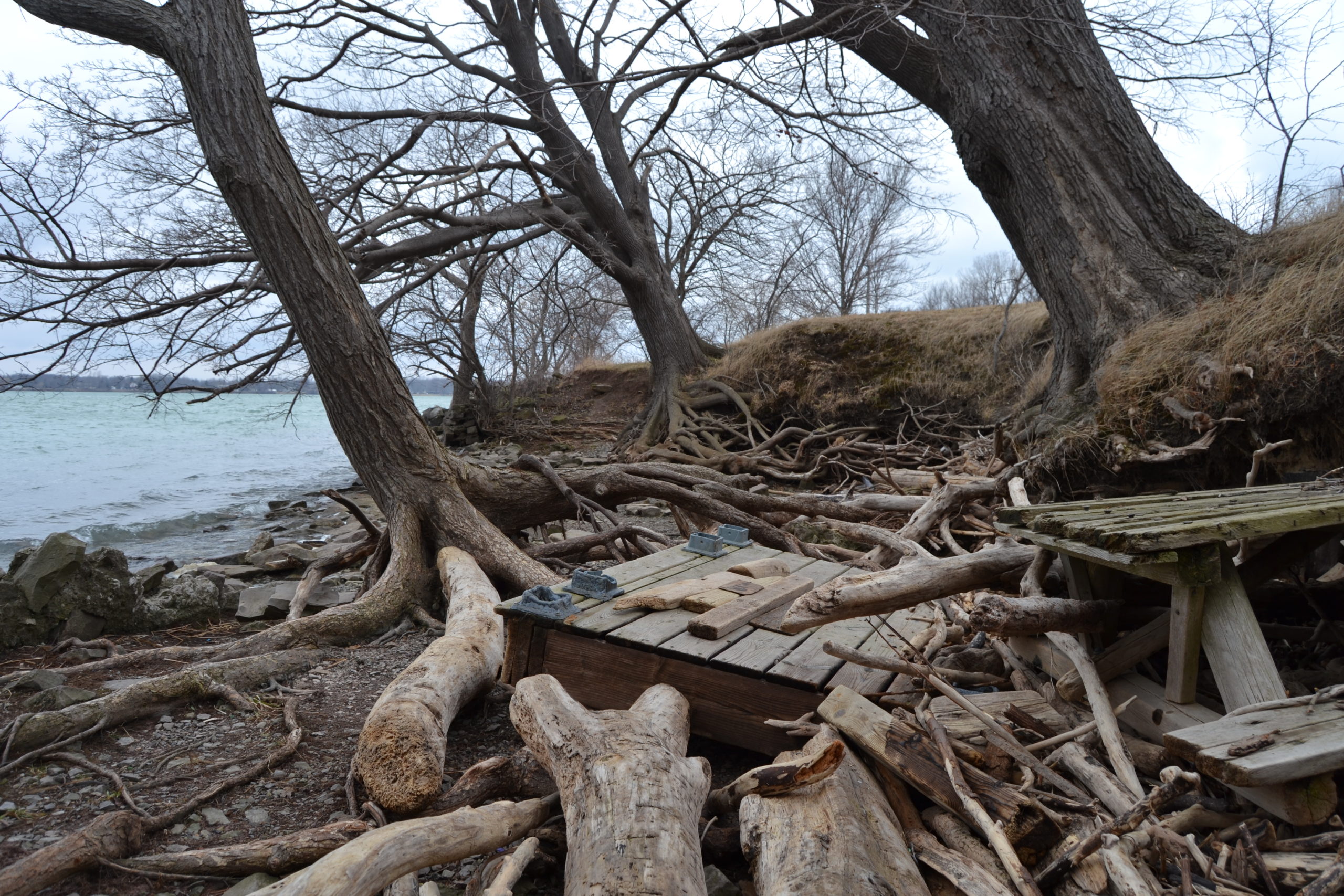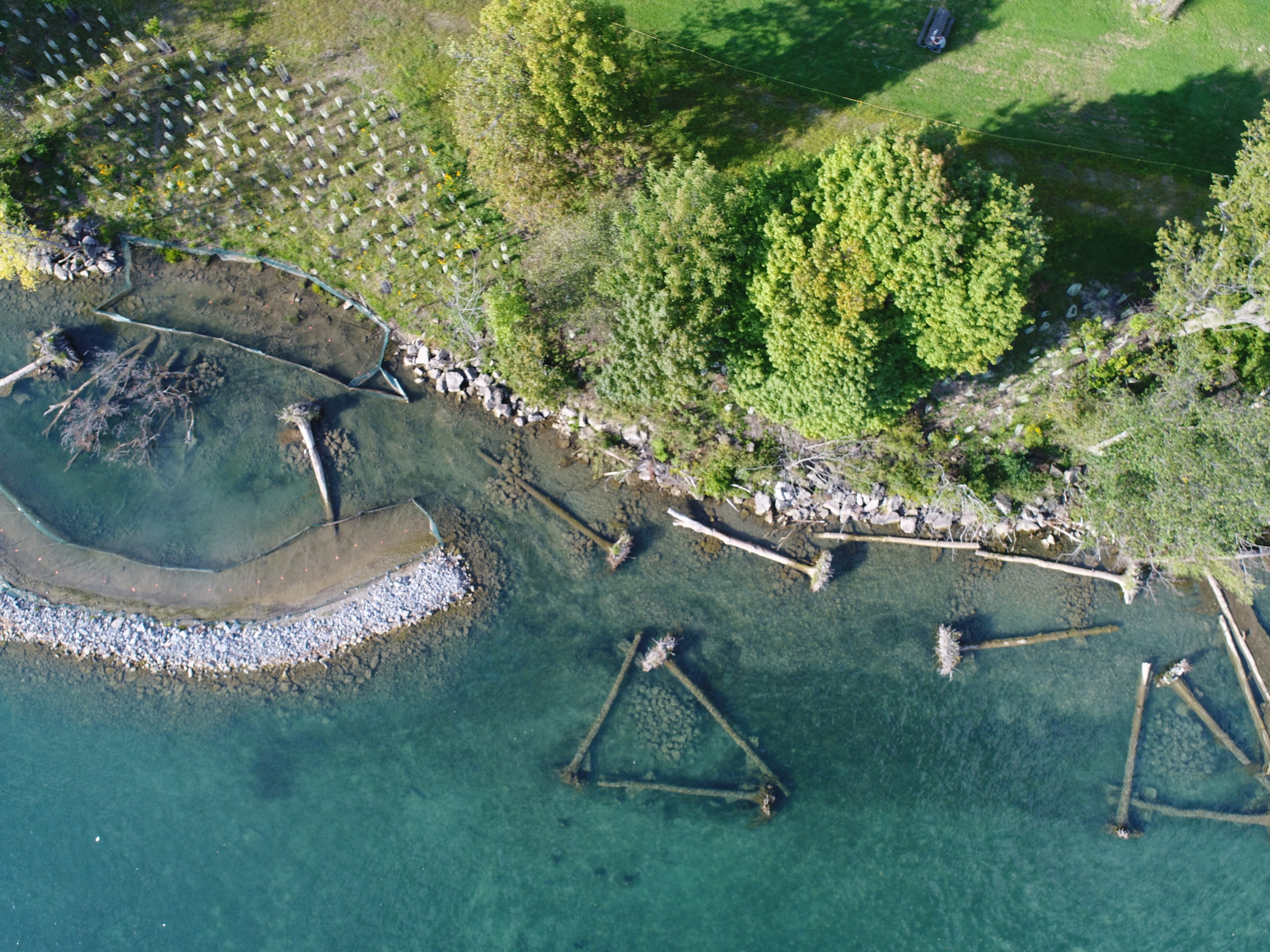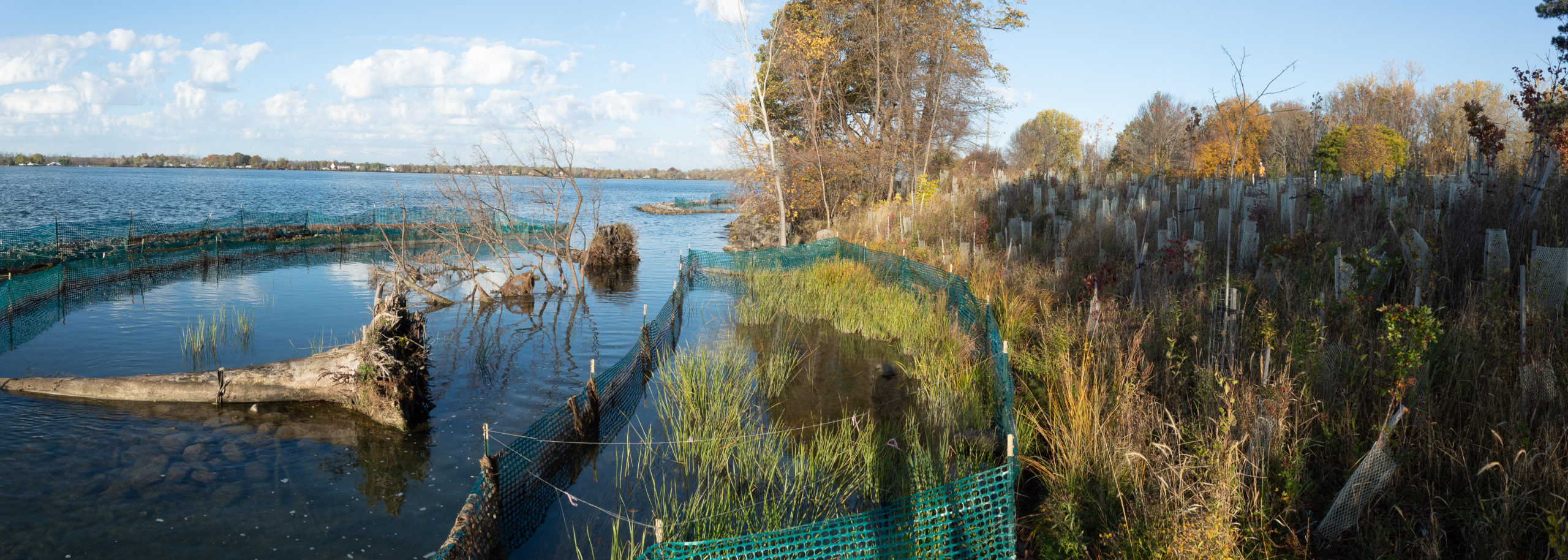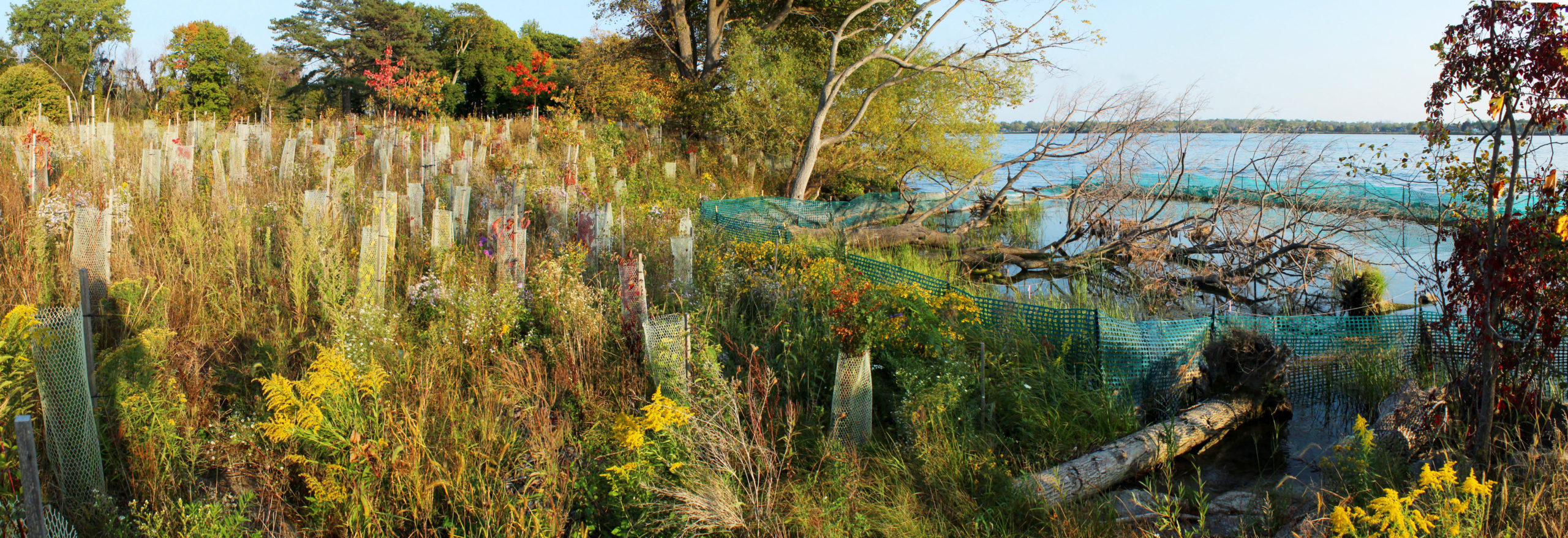Using, Not Abusing, Mother Nature | Restoration
By: ajcarapella

Buffalo Niagara Waterkeeper is restoring shorelines along the Buffalo and Niagara rivers to stop erosion, restore wildlife habitat, and filter certain types of pollution — like lawn fertilizer and pet waste — before they reach waterways.
By Lisa W. Foderaro
Golf courses are notoriously unnatural, with their chiseled links, gouged-out sand traps, and fastidiously clipped putting greens. It should come as no surprise, then, that where many golf courses meet water bodies, the interface is only vaguely reminiscent of a natural shoreline.
So it was at Spicer Creek, a major tributary of the Niagara River that flows through River Oaks Golf Club in Grand Island, New York, between the city of Buffalo and Niagara Falls. Because the golf course met the creek abruptly, without a soft or natural edge, both erosion and nutrient pollution were recurring problems.
Enter Buffalo Niagara Waterkeeper. For the past decade, the organization has embarked on a series of shoreline restoration projects along both the Buffalo and Niagara rivers, as well as tributaries like Spicer Creek. The idea behind its “Living Shorelines” initiative is to reclaim natural features of riverbanks to stop erosion, restore wildlife habitat, and filter certain types of pollution — like lawn fertilizer and pet waste — before they reach waterways.
“Our shores have been severely degraded through land-use changes and development,” said Emily Root, director of ecological programs for Buffalo Niagara Waterkeeper. “But shorelines are some of the most ecologically productive places on earth. So for us, they are a high priority for improving the ecological health of the region.”
The project at River Oaks, completed last fall, represents a critical part of the Waterkeeper’s work, especially in the face of climate change. Jill Jedlicka, the organization’s Waterkeeper and executive director, says restoring shorelines — so that they harness nature’s healing powers — is every bit as important as removing contaminated sediment or boosting access to riverfronts. On a warming planet, re-establishing native plants, from emergent aquatics to shrubs to trees, can absorb and store carbon, while also making properties more resilient against floods and extreme weather.

At River Oaks Golf Club, the group set out to take a highly manipulated landscape and reconnect it to the creek. Along 5,000 feet of shoreline, the Waterkeeper engineered a more gradual slope, oversaw the installation of native species like pickerel weed and little bluestem, and convinced the golf course to stop mowing some 80 acres.
“Science really drove this project,” Root said. “This was an area with a lot of runoff, and so we created step pools to capture the water as it flowed through the landscape. We also regraded the shoreline to reconnect it to the flood plain. In springtime, there are a ton of tadpoles in that area now.”
But the task of restoring shorelines is enormous, not to mention time-consuming and costly — factors that might make less fierce advocates shrink from the challenge. Along the Buffalo River, within the city limits of Buffalo, work to improve habitat across 17 sites is now finished. But work along the Niagara River Greenway, which began in 2013, continues.
About 80 percent of the shoreline along the upper Niagara River has been altered from its natural form, according to Buffalo Niagara Waterkeeper’s own estimates. The group has partnered with local municipalities, state agencies, and private landowners on the projects. And it chooses its restoration sites judiciously.
“How do you reach a golfing community and the demographics of people who love to golf?” Jedlicka asked. “When you understand your local waterways, you can start to prioritize better, and it helps to have a highly visible project like this.”
The hope is that visitors to a restored site, whether a golf course, nature preserve, or state park, will see a shoreline lush with natural grasses and shrubs, and might advocate for similar restoration elsewhere. Homeowners fortunate enough to live along rivers and creeks are encouraged to landscape their own properties in a way that harmonizes with nature.

But while the restored shorelines may look as if they have sprung from nature, returning them to their origins involves complex planning and design. A process known as bioengineering is deployed, with stones, boulders, log barriers, and native plant species all bolstering the shore against wind and waves. Plant species that withstand drought and floods are favored over fragile ones.
Such was the case at Tifft Nature Preserve in Buffalo. In the 1970s, the preserve was carved out of a long-abused property — a 264-acre patch of land connected to Lake Erie via a long culvert. Historically, the land was a fertile network of wetlands next to the great lake. But during the city’s industrial heyday, it was used as a turning basin for ships. Later, it became a dump for garbage, chemical waste, and construction debris.
Yet nature has slowly reclaimed the area, and pied-billed grebes and American wigeons — ducks prized by bird-watchers — are commonly seen there. Before the pandemic, school groups would arrive at the visitor center throughout the year for education programs, learning about the preserve’s transformation.
The visitor center sits next to Lake Kirsty. Once part of a sprawling wetland, the manmade lake was created to accommodate ships. Buffalo Niagara Waterkeeper decided to renovate a portion of the lakeshore to show visitors the ability of native plants to attract wildlife, even along once-contaminated water bodies.
The preserve staff had already managed to rid the shoreline of Japanese knotweed, a highly invasive plant. In order to raise the bed of the lake where it met the land, Waterkeeper brought in tons of clean soil, depositing it along 500 feet of shore. (Using construction equipment to regrade the slope was not an option, since it could stir up contaminants.)
“There was no gradual transition before,” said Zach Goodrich, the preserve steward, who worked closely with Waterkeeper on the project. “It was a rocky shoreline and then it dropped a couple of feet immediately. Now there is a nice gentle slope. And it’s a great example of an emergent plant community that kids can see right outside the visitor center, where we hold workshops.”

Goodrich hopes to extend the restoration to other parts of the lakeshore. The aquatic plants provide important cover for fish like rock bass, sunfish, and perch, he said, as well as spawning habitat. As the plants mature, he expects birds like American bitterns and herons, which are seen in the preserve’s 75-acre wetland, to discover the lakeshore as well.
As in all of Waterkeeper’s shoreline projects, the plants at the Tifft preserve are not limited to the lake’s edge. They extend from beneath the water’s surface to the uplands, some 30 feet from shore. Forty different plant species were used in the restoration, ranging from aquatics like American white water lily to shrubs such as fragrant sumac and elderberry and trees like gray birch and hackberry.
The new plants at Tifft Nature Preserve not only look beautiful; they strengthen the shore. Climate experts say flooding, and extreme weather in general, are likely to worsen with global climate change.
“There is a constant fluctuation in water levels because we are connected to Lake Erie,” Goodrich noted. “The level can rise or fall by one or two feet in only an hour due to wind. When we have a big wind event, the elevations of the lake go down by Toledo on the west, and the water on our side goes up.”
Those forces are also at work on Little Beaver Island, part of Beaver Island State Park on the upper Niagara River. There, a four-acre project is centered on a portion of shoreline that is buffeted by waves. “It’s in an area on the Niagara that is high-energy, with boat wakes and wind-driven waves and ice,” Jedlicka explained.
The solution was a trio of barrier rock reefs that were constructed offshore as part of the restoration. The reefs protect the banks, which were previously scoured by waves, and allow aquatic plants like common threesquare to take hold. The newly planted shoreline, together with the reefs, offers habitat for birds, native mussels, and turtles.
“Certainly the turtles we watch in New York State are the eastern spiny softshell, which is known to use the other side of the island,” said Aaron W. Heminway, a biologist for the New York State Office of Parks, Recreation and Historic Preservation, a partner on the project. “And, of course, painted turtles.”
Dying ash trees — victims of the invasive emerald ash borer — were also cut down, cabled together and deposited offshore as part of the $1.78 million project. “The upper Niagara is known for game fish like musky, pike and largemouth bass,” Heminway added. “The cabled logs create habitat for them and provide shelter for minnows and other species that are preyed upon.”
The project, completed in 2019, has already proved its worth, Jedlicka said. “We had some really crazy ice storms the winter after this was constructed, with car-sized ice chunks,” she said, pointing out that the shore came through relatively unscathed. “We knew right away that it was resilient.”
With climate change posing an existential threat, Jedlicka believes shoreline restoration can address both prevention and preparedness. “We know the work we do is not going to save the planet,” she said. “But any time you put a plant or tree in the ground, it sequesters carbon, even on a micro-scale. In terms of resiliency, we’re using Mother Nature to deal with whatever is thrown her way.”